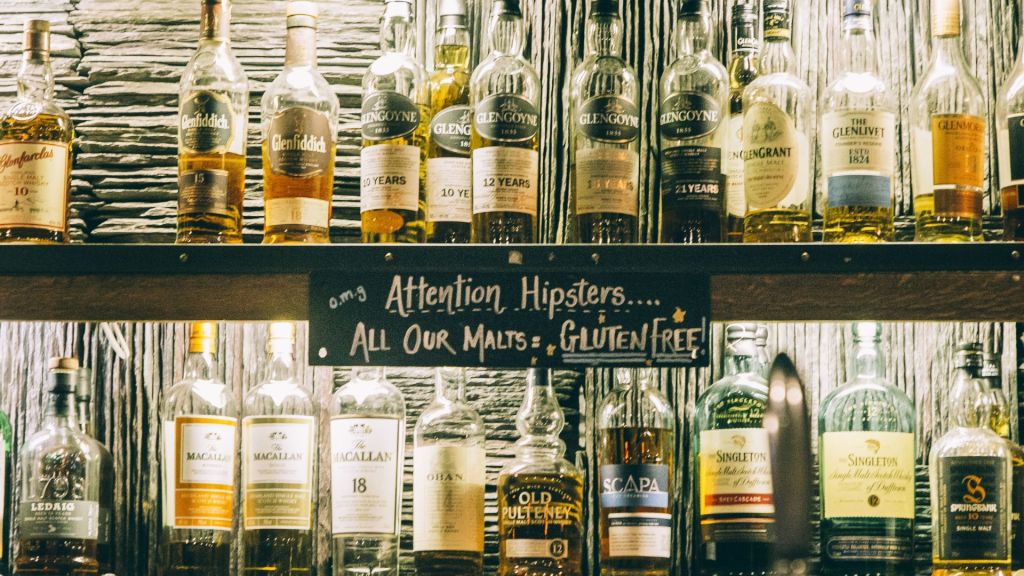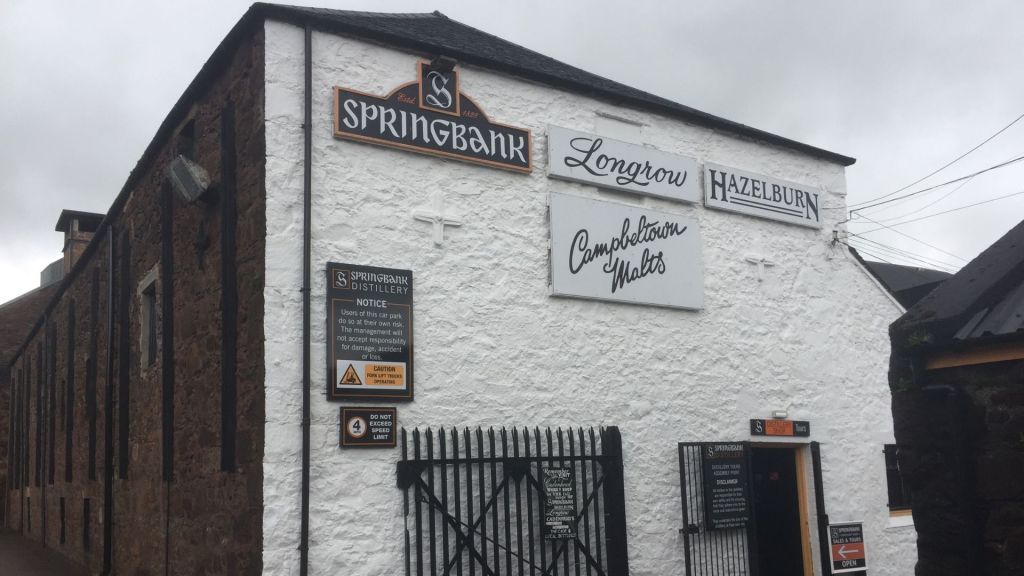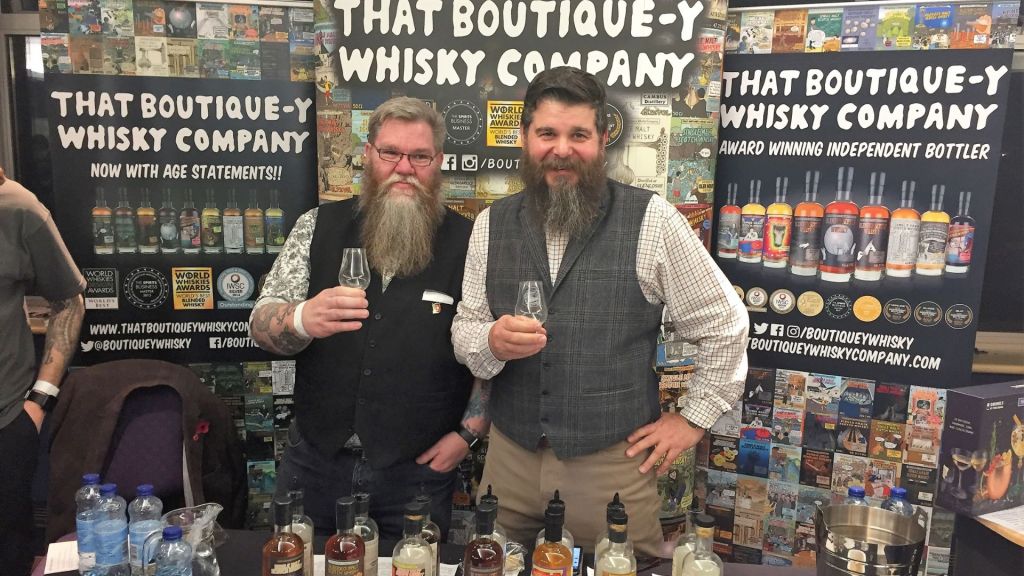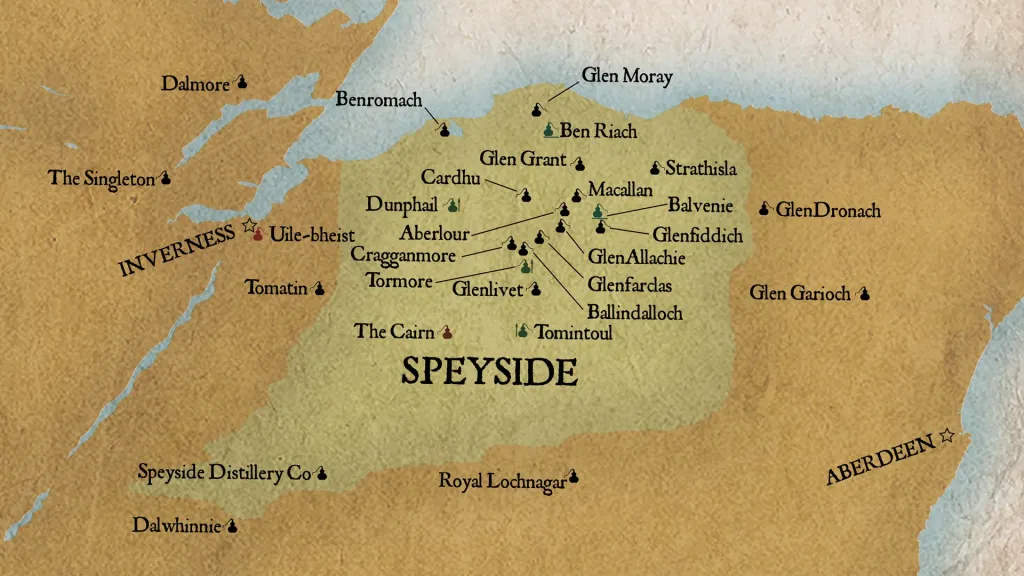Scotch Whisky Distillery Map: Discover the Hidden Gems and Legendary Distilleries of Scotland’s Whisky Trail

Venture on a whisky journey through the stunning landscapes of Scotland with our beautifully designed Scotch Whisky Distillery Map. This comprehensive guide invites you to explore and visit some hidden distilleries and legendary producers that define Scotland’s iconic Whisky Trail.
By 2023, there were 145 whisky distilleries in Scotland. However, not all of them are open for tours and tastings. The following article and map focus on the distilleries with open visitor centres. Distilleries you can actually go, pay a visit and take a tour. Now, if you are looking for a complete map of active Scottish distilleries (every single one), you can check this map developed by the Scotch Whisky Association (SWA). This blog aims to help you plan your next whisky adventure in Scotland as we navigate each region, featuring the distilleries a whisky enthusiast should never miss.
Moreover, we will explore some less famous distilleries that have yet to be widely known to the public. These distilleries offer unique whiskies that showcase their distinct characteristics, from unconventional maturation techniques to exclusive terroir attributes.
Let the Scotch Whisky Distillery Map be your compass for your next whisky adventure across the Scottish culture, whisky and fantastic distilleries along the highlands and islands.
What is Scotch whisky?

Before we go deeper into the Scotch whisky distillery map, it is essential to clarify the meaning of Scotch Whisky. To be considered Scotch whisky, it must be made in Scotland and aged in oak casks for at least three years. The production process involves mashing malted barley, fermenting the mash, distilling the liquid, and ageing it in oak barrels. The unique combination of ingredients, fermentation times, pot stills and ageing techniques contribute to the diverse flavours of the whisky.
Scotch whisky is also classified into several types: single malt, single grain, blended malt, blended grain, and blended whisky. Each class offers a unique taste experience and is crafted with different techniques. Please keep in mind that within the Scottish borders, you will only find single malt and single grain whisky distilleries. There’s no such thing as the “Johnnie Walker Distillery” or the “Chivas Regal Distillery”. Johnnie Walker and Chivas (among many others) are blended whiskies, and blended whiskies are not distilled in a “single” place. Blended whiskies combine various whiskies from different distilleries and different grains, E.g., corn, wheat, rye, and even malted barley.
Brief history of Scotch whisky distilleries
The history of Scotch whisky distilleries dates back centuries and is intertwined with Scotland’s cultural heritage. It is believed that the art of distillation was introduced to Scotland by monks in the late 15th century. Initially, whisky production was not regulated, and many farmers and landowners operated small-scale illicit stills. However, in the 18th century, the government imposed taxes and regulations on whisky production, leading to the establishment of legal distilleries.
In the 19th century, it became a common practice to mature spirits in wooden casks. This was due to the abundance of barrels used to transport rum, wine, and sherry to the UK. As a result, there was no longer a need to add herbs and spices to the spirit to enhance its taste. The cask naturally imparts its flavours and aromas to the spirit during maturation.
It was soon discovered that using barrels that had previously transported sherry was necessary for maturing whisky. However, the popularity of sherry declined over time, and from 1986, it was bottled in Spain before being transported abroad. This caused a shortage of sherry casks and made them more expensive. To tackle this issue, some distillers asked Spanish cooperages to recreate transportation casks and fill them with sherry for a few months to “season” them before using them to mature their whisky.
Due to the scarcity of Sherry butts, many distilleries have chosen to use second-hand barrels from the growing bourbon industry. According to tradition and law, bourbon must be aged in virgin oak barrels that have been charred, which can only be used once. As a result, these barrels have become widely available. Most of all, Scotch whisky is matured in American oak casks previously used to hold bourbon.
During the 1800s, the whisky industry evolved, and more players began to legalise their operations. Some famous distilleries that took advantage of the Excise Act 1823, which eased restrictions and taxes, were The Glenlivet, Bowmore, Strathisla, Balblair, and Glenmorangie. Scotch whisky produced in Scotland gained international recognition for its quality and craftsmanship. Today, Scotland’s distilleries continue to honour these traditions while using modern technology to meet the growing demand for Scotch whisky.
Exploring the different regions of Scotland’s whisky trail
Scotland’s whisky trail is divided into several distinct regions, each offering a unique experience. From the worldwide famous Speyside and the Highlands distilleries to the boutique and crafted distilleries of Islay and Campbeltown, each region has its own characteristic flavours and styles of whisky.
The Lowlands region has transformed the whisky industry in the last two decades. Historically, the area produced a poor quality spirit due to distillers rushing through production, resulting in a harsh and raw spirit. Recently, there has been a renewed interest in the beauty and heritage of the Lowlands, leading to new distilleries that are expanding the profile of local whisky in flavour and techniques.
New distilleries not to be missed within the Lowlands region if you are planning your next visit to Scotland are:
- Rosebank Distillery
- Kingsbarns Distillery
- The Holyrood Distillery
- Port of Leith Distillery
- The Clydeside Distillery
- The Borders Distillery
- Annandale Distillery
- Bladnoch Distillery
Learn more about the Lowlands here.
The Highlands region is the biggest (geographically) producer of whisky in Scotland. It offers various styles, from light and floral whiskies in the southern highlands to rich and full-bodied drams in the northern and northwestern highlands.
When people think of Scotland, the most common image that comes to mind is the vast, wild, almost prehistoric landscapes covered in heather and rocks. The Highlands region stretches north of an imaginary line that connects the Firth of Clyde to the Firth of Tay, cutting midway near Stirling and leaving out only Islay, Campbeltown, and Speyside. Covering such a wide area, whiskies are incredibly diverse.
The complete list of distilleries you can visit in the Highland region could be a neverending story, and you would probably require several weeks to see them all. The following are some of the newer distilleries you should consider visiting:
- Lindores Abbey Distillery (Eastern Highlands)
- Arbikie (Eastern Highlands)
- Uile-Bheist (Inverness)
- Nc’nean (Western Highlands)
- Ardnamurchan (Western Highlands)
- Wolfburn (Northern Highlands)
- 8 Doors (Northern Highlands)
- Torabhaig (Isle of Skye)
- Raasay (Isle of Raasay)
- Harris (Isle of Harris)
Learn more about the Highlands here and here.
Speyside, located in the northeast of Scotland, is often called the heartland of Scotch whisky. It is home to Scotland’s highest concentration of distilleries, including famous names like Glenfiddich, Macallan, and Glenlivet. Speyside whiskies are known for their fruity and floral notes, making them a favourite among enthusiasts worldwide.
Speyside’s malt whisky trail, stretching from Moray Firth to Cairngorms National Park, is a must-visit for whisky lovers. With over 50 active distilleries, it’s Scotland’s most densely populated region. The trail is named after River Spey, which has clear water sources perfect for whisky production.
Here is a list of distilleries we encourage you to visit on your next trip to the region. There are many more, but the ones below are the ones we consider more attractive. (Check also the famous distilleries and hidden gems sections below)
Learn more about Speyside here.
On the west coast is a small island known as the spiritual capital of whisky. Islay is famous for its unique, peaty and smoky whiskies. The island is home to iconic distilleries such as Ardbeg, Lagavulin, and Laphroaig, which produce highly sought-after whiskies for peat lovers. Islay’s natural beauty enhances the distilleries’ allure, making it a must-visit destination for whisky enthusiasts.
Islay is a top-rated destination for whisky fanatics. The area currently boasts nine distilleries that produce whisky, with plans to build more soon. However, some people have expressed concerns that Islay may become overburdened with so many distilleries in the long run.
If you plan to visit the island soon, organise your itinerary to ensure you can visit them all. However, if you are short on time, my highlights are:
Learn more about Islay here.
And finally, a whisky region famous for producing whisky with a briny yet spicy character. Despite having only three distilleries, this region has become quite popular. However, it’s worth noting that in the early 1800s, Campbeltown had around 34 distilleries. Only three distilleries are left, interlaced in the town’s urban landscape. These distilleries include two traditional pillars of the area, Glen Scotia and Springbank, and the newest addition, Glengyle. Since they are all almost across the road, avoiding trying a whisky sample from each would be discourteous.
Learn more about Campbeltown here.
Famous distilleries on Scotland’s whisky trail
Scotland’s whisky trail is dotted with famous distilleries that have shaped the history and reputation of Scotch whisky. These distilleries are renowned for their exceptional quality, history, heritage, and marketing.
Glenfiddich, located in Speyside, is one of Scotland’s most famous and celebrated distilleries. Founded in 1887, it is known for its triangular bottle and classic approach to whisky production. Glenfiddich is the largest whisky distillery in Scotland and the best-selling single malt whisky in the world. Their visitor centre is genuinely fantastic, and they offer two distillery tours to explore and discover the secrets behind the Glenfiddich spirit:
- Glenfiddich Distillery Tour
- Glenfiddich Solera: Deconstructed Tour
The Macallan is a renowned Speyside distillery that is often associated with luxury. Established in 1824, it is highly regarded for its sought-after whiskies, popular among collectors and investors. If you are a fan of sherry bomb whiskies, then this is a great distillery to explore, as Macallan is mainly aged in sherry casks. The distillery was renovated in 2018, and its new look is beyond impressive. Whether you are a devoted Macallan enthusiast or not, the distillery is a must-visit destination for whisky lovers of all preferences.
Some of the tours and tastings you can do at the Macallan Distillery are:
- The Discovery Experience
- The Mastery Experience
- The Story of Oak
- The Macallan Through the Ages
The Glenlivet Distillery has an exceptional visitor centre and boasts an iconic place in history. They were one of the first distilleries to start the malt revolution that we know today and even the blended whisky revolution that contributed to the kick-off of the golden age of the whisky industry during the 1800s. The Glenlivet has played a significant role in the industry throughout the years and, along with Glenfiddich, disputes the position of the best-selling single malt whisky in the world every now and then. It is a well-deserved place for a whisky, probably the most important Scotch in history, “the malt that started it all.”
Some of the tours you can book at The Glenlivet Distillery are:
- The Original Distillery Tour
- The Visionary
- The Reflection
- Single Cask Whisky Tasting
- The Generations
- The Archives Warehouse Tour
These distilleries represent just a fraction of the famous names on Scotland’s whisky trail. Each distillery has its unique story, production techniques, and whiskies that showcase the artistry and passion behind Scotch whisky.
Hidden gems and lesser-known distilleries to visit

While the famous distilleries on Scotland’s whisky trail are undeniably worth a visit, hidden gems and lesser-known distilleries offer a more intimate and exclusive whisky experience. These distilleries often fly under the radar but produce exceptional whiskies that capture the essence of their surroundings.
Springbank Distillery is a must-visit in Campbeltown for whisky enthusiasts exploring beyond the well-known names. Founded in 1828, it is one of the oldest legal distilleries in Scotland, but most importantly, it is one of the few distilleries in Scotland that can proudly say that they produce their whisky entirely from grain to bottle. If you are looking for the whole whisky experience, including a visit to their malting floors (a rarity these days), Springbank Distillery is the way to go.
Kilchoman on the Isle of Islay is a hidden gem in the world of whisky. Although it was founded in 2005, it has quickly become a favourite among whisky enthusiasts and drinkers alike. Kilchoman is known for its typical peaty and smoky flavour, similar to other distilleries on the island. However, Kilchoman sets itself apart by innovating with different cask finishes, local barley editions, and special releases each year. Additionally, at the Kilchoman Distillery, you can witness an authentic malting floor in operation, as well as all the other peat-related matters their whisky requires. Indeed, it is a whisky experience not to be missed!
The Balvenie Distillery in Speyside is an exceptional experience. The distillery used to be closed to tourists, but recently, they have changed their mind, and it’s open to the public. The atmosphere at The Balvenie distillery is relaxed and personal, allowing you to ask questions, offer comments, and sample the exceptional single malt whiskies produced by The Balvenie. You will have the opportunity to try whatever they have available during your visit, and if you’re fortunate, you may even get the chance to taste exceptional whiskies. During the tour, you will gain a detailed understanding of each stage of the whisky-making process, including Balvenie’s malting floor (Yes, they have it too).
Additionally, the distillery is situated in Dufftown, the Scottish whisky capital. This means you can easily visit other distilleries, shops, accommodations, and restaurants in the area. The distillery often goes out of the radar since its sister distillery, Glenfiddich, is just a few steps away; however, if you only have time for one of them, we highly encourage you to visit Balvenie.
Tips for planning your whisky trail journey
Planning a whisky trail in Scotland can be daunting, with many regions and distilleries to explore. Below are some tips to make the most of your journey.
- Research and prioritise: Before setting off, research the distilleries and regions you want to visit. List your must-see distilleries and prioritise them based on your preferences. Based on experience, you will likely see up to two distilleries per day.
- Allow ample time: Scotland’s whisky trail spans a vast area, and each distillery deserves time for exploration and tasting. Allow enough time at each location to fully immerse yourself in the experience.
- Consider guided tours: Many distilleries offer guided tours that provide valuable insights into the whisky-making process. These tours often include tastings and allow you to learn from knowledgeable guides. Booking your tour in advance is highly recommended.
- Transportation plan: The distilleries on Scotland’s whisky trail are often located in remote areas. Consider renting a car or joining a guided tour that provides transportation to ensure easy access to the distilleries.
- Drink responsibly: Whisky tasting can be an enjoyable experience, but it’s essential to sample responsibly. Pace yourself and drink loads of water. Avoid excessive alcohol consumption.
- Collect whisky souvenirs: Many distilleries have gift shops where you can purchase bottles of whisky, glassware, and other souvenirs. Collecting a bottle from each distillery, you visit can be a cherished memento of your whisky trail journey.
By following these tips, you can make your whisky trail journey a memorable and fulfilling experience.
Whisky tasting and tours at distilleries
One of the highlights of visiting Scotland’s distilleries is the opportunity to indulge in whisky tastings and tours. Distilleries offer a range of tasting experiences, allowing you to explore different expressions and discover your favourite flavours.
Tasting sessions often include a selection of whiskies accompanied by knowledgeable guides who provide insights into the distillery’s history, production techniques, and flavour profiles. Whether you prefer light and floral, rich and smoky, or something in between, there is a whisky-tasting experience to suit your preferences.
In addition to tastings, distilleries offer guided tours that take you behind the scenes of whisky production. These tours glimpse the distillation process, from mashing and fermentation to distillation and maturation. You can witness the skilled artisans at work and gain a deeper understanding of the artistry of creating each bottle of whisky.
Some distilleries even offer exceptional cask experiences, where you can fill and label your own bottle straight from the cask. These exclusive experiences allow you to take home a truly unique whisky that is a testament to your whisky journey.
Whisky events and festivals on Scotland’s whisky trail

Scotland’s whisky trail is not limited to distillery visits alone. Throughout the year, various whisky events and festivals take place, offering whisky lovers the opportunity to immerse themselves in the world of Scotch whisky.
The Spirit of Speyside Whisky Festival, held annually in Speyside, is one of Scotland’s most renowned whisky events. It celebrates the region’s whisky heritage with tastings, masterclasses, distillery tours, and live music. The festival attracts whisky enthusiasts worldwide, who come together to indulge in their shared passion for Scotch whisky.
Another notable event is the Islay Festival of Malt and Music, Feis Ile. Held on the island of Islay, this festival showcases the unique charm of Islay whiskies through tastings, distillery open days, traditional music performances, and ceilidhs. It is a vibrant celebration of Islay’s whisky culture and a must-visit for whisky lovers.
These events offer a chance to connect with fellow whisky enthusiasts, learn from industry experts, and experience the vibrant atmosphere of Scotland’s whisky community.
To learn more about whisky festivals, we recently posted another article highlighting the 8 best whisky festivals in Scotland.
Conclusion: Uncover the magic of Scotland’s whisky trail
Scotland’s whisky trail is a treasure trove of history, craftsmanship, and flavours waiting to be discovered. From the iconic distilleries that have shaped the industry to the hidden gems that offer a more intimate experience, each stop along the trail provides a unique glimpse into the world of Scotch whisky.
If you’re interested in exploring and learning about whisky directly from the source, this article and the Scotch Whisky Distillery Map will guide you through the journey. Whether you’re an experienced whisky connoisseur or a curious traveller, the whisky trail is an expedition you will never forget.
Finally, if you’re planning a trip to Scotland but need help figuring out where to start, this is something we can help! We’ve been visiting distilleries and sharing our love of whisky with thousands of customers since 2017. If you have any questions or need help with anything whisky-related, don’t hesitate to contact us. We’re here to assist you!




